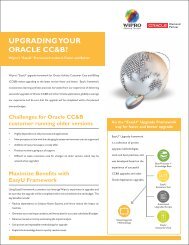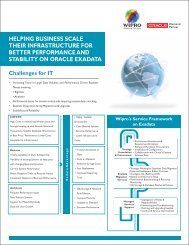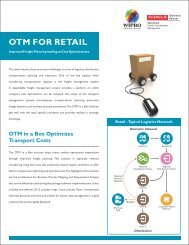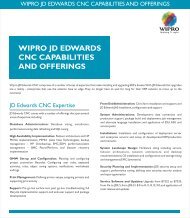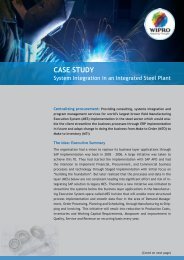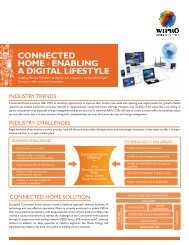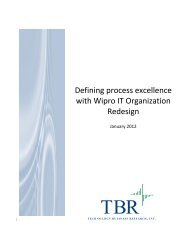Create successful ePaper yourself
Turn your PDF publications into a flip-book with our unique Google optimized e-Paper software.
03 04<br />
W<strong>IN</strong>SIGHTS<br />
<strong>MOV<strong>IN</strong>G</strong> <strong>FORWARD</strong> <strong>IN</strong> <strong>REVERSE</strong><br />
Why U.S. Telecom Firms Should Forget the Past<br />
FROM DUMB PIPES<br />
TO SMART SERVICES<br />
We do not envy U.S. telecom CEOs. At a<br />
time of rapid change, potent forces chip<br />
away at their traditional business model.<br />
Surrounded by device makers, content<br />
providers, social networks and an array of<br />
disruptive technologies, the carriers face a<br />
daunting challenge. They must find a way<br />
to transition from owning and operating<br />
so-called “dumb pipes” to creating new<br />
portfolios of smart network services.<br />
Owning a slew of dumb pipes was a good thing as they<br />
formed the heart of the telecom business – a source of<br />
healthy rents and toll from voice traffic that flowed<br />
through. And telecom carriers made all real-time<br />
communication happen. But, now they run the risk of<br />
marginalization. A stark example is the Apple iPhone that<br />
runs on the AT&T network. Customer loyalty is higher<br />
to Apple than AT&T. Given the phone's versatility,<br />
interface, and apps, they credit Apple for everything they<br />
admire but blame AT&T for dropped calls and dead<br />
zones. So, it's a win-win for Apple and not so much<br />
for AT&T.<br />
Every business finds it tough to abandon the way they<br />
traditionally defined themselves. However, in order to turn<br />
things around, U.S. carriers will have to ditch their<br />
devotion to infrastructure ownership and embrace a new<br />
business model.
05 06<br />
W<strong>IN</strong>SIGHTS<br />
Though not easy, telecom CEOs can draw lessons from “reverse innovation” or breakthrough ideas that<br />
originate in emerging markets and are powerful enough to conquer the developed world.<br />
THE SOLUTION<br />
We would like to propose a solution. In a<br />
fast-changing industry, massive infrastructure<br />
investments can burden balance<br />
sheets and cut flexibility. U.S. telecom<br />
companies should turn themselves into<br />
lean and agile virtual organizations – ones<br />
built for 21st century challenges. Though<br />
not easy, telecom CEOs can draw lessons<br />
from “reverse innovation” or<br />
breakthrough ideas that originate in<br />
emerging markets and are powerful<br />
enough to conquer the developed world.<br />
A case in point – India's telecom boom!<br />
HOW <strong>IN</strong>DIA COPED?<br />
To say that the Indian market grew fast<br />
would be an understatement. From 1994<br />
to the present, telecom coverage across<br />
the population grew from less than one<br />
percent to 53 percent. Over the past<br />
decade, subscription grew from 6 million<br />
to 690 million (land lines plus mobiles), a<br />
35 percent compound annual growth rate.<br />
Astonishing numbers even without<br />
factoring in the market constraints of an<br />
underdeveloped and unreliable power grid<br />
and a vast, poor, and predominantly rural<br />
nation outside of the major urban centers.<br />
Indian telecoms staggered under the<br />
burden of network building costs and<br />
meeting overwhelming demand for<br />
services as government liberalized<br />
regulatory policies to stimulate market<br />
growth. Competition for customer<br />
acquisition was so cut-throat that telecom<br />
calling plans seldom covered costs.<br />
Something had to give. Bharti Airtel, an<br />
entrepreneurial upstart whose<br />
competitive strengths lay in marketing and<br />
customer acquisition, was the first to<br />
recognize that infrastructure-building<br />
diluted its core advantage. In 2004, it<br />
developed a strategy to outsource<br />
network installation, maintenance and<br />
service to Ericsson, Nokia, and Siemens;<br />
and got IBM to take over the internal IT<br />
systems and services. These steps freed<br />
Airtel from the sustained and huge upfront<br />
investments that a growing market drove.<br />
It also enabled them to focus on core<br />
competencies. Another Indian provider,<br />
Aircel, adopted a similar model working<br />
with Wipro and Alcatel-Lucent.<br />
BENEFITS OF<br />
OUTSOURC<strong>IN</strong>G<br />
Outsourcing is a well-established hedge.<br />
With increasing speed, yesterday's core<br />
becomes today's commodity. But even<br />
mature technologies serve the needs of<br />
important customer segments. Once firms<br />
identify non-core activities and assets that<br />
can safely be managed by capable third<br />
parties, they accomplish these<br />
valuable economies:<br />
• They can offload the burden of non-core<br />
network ownership (maintenance, repair,<br />
and replacement of infrastructure)<br />
• They pay only for the services that they<br />
and their customers consume<br />
• They are able to reserve more enterprise<br />
capital for investment in core activities<br />
• And, they liberate management bandwidth<br />
to focus on highest-value strategies<br />
Structure contracts (Airtel's deal with<br />
IBM) that eschew fixed fees or<br />
“time-and-material” models, instead<br />
including profit-share incentives, make<br />
service providers into “partners” in a<br />
client's success. Once Bharti Airtel made<br />
its move, other Indian telecoms followed<br />
suit. Freed from the management drain of<br />
network and infrastructure issues, the<br />
carriers innovated on service offerings<br />
tailored to Indian customer preferences.<br />
WILL IT WORK <strong>IN</strong><br />
THE U.S.?<br />
Certainly, there are differences in the ways<br />
that Indian and U.S. markets work. Bharti<br />
Airtel, with its entrepreneurial roots and<br />
little experience in telecom, was ideologically<br />
unconnected to past industry<br />
practice and identity. Nonetheless, we<br />
firmly believe that benefits similar to what<br />
Airtel and its competitors achieved<br />
from network outsourcing are available<br />
to U.S. telecoms – if only they can let<br />
go of the past and find inspiration in<br />
reverse innovation!<br />
In fact, one U.S. telecom has already<br />
moved. Sprint Nextel signed a seven-year<br />
deal to outsource its network operations<br />
to Ericsson, a contract worth about<br />
$5 billion. European wireless carriers are<br />
negotiating deals in growing numbers.<br />
When such deals occur, a snowball effect<br />
typically produces greater economies of<br />
scale for both clients and providers. But we<br />
believe that the main – and most strategic<br />
– benefit that U.S. carriers will realize is<br />
the flexibility to control their own destiny<br />
in an increasingly complex ecosystem.<br />
Times of uncertainty and complexity are<br />
often the enemies of courage. On the<br />
other hand, they are also the times when<br />
courage is most generously rewarded.




